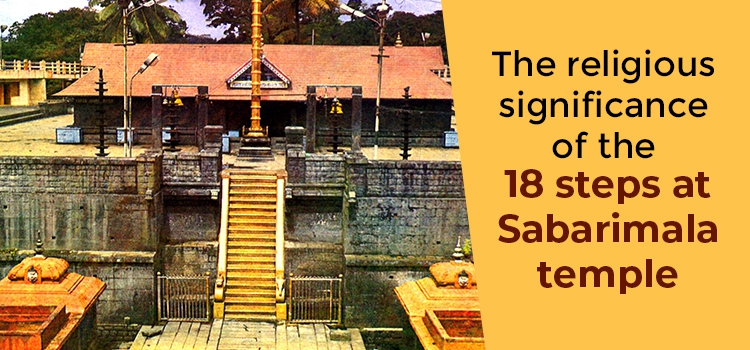The Religious Significance Of The 18 Steps At Sabarimala Temple
Sabarimala Ayyappa temple in Kerala attracts devotees from all parts of India. Located in a dense forest, which is also a protected tiger reserve, the pilgrimage to Sabarimala involves severe austerities that span a mandala or 41 days, during which the devotee observes a strict fast, refraining from all kinds of indulgences like alcohol, non-vegetarian food, and even sex. After the Mandala Kaalam begins, they also take to wearing black clothes, going barefoot, sleeping on the floor, and taking baths in cold water as part of the austerities. During these 41 days, the devotee is expected to lead a simple and pious life.

Mandala Pooja and Makaravilakku Rituals:
Mandala Pooja, an important ritual, is observed at the Sabarimala Ayyappa Temple when the 41 days of austerity called Mandala Kaalam come to an end. The fast commences on the first day of Vrishchikam (November – December) Malayalam month.
Along with Mandala Pooja, there is an important festival called ‘Makara Vilakku’. This annual festival is held on the day of Makara Sankranti, at the Sabarimala shrine. The Thiruvabharanam (sacred ornaments of Lord Ayyappan) procession and a congregation at the hill shrine are the main features of this festival.
During the procession, the Lord’s jewels are taken to the Old Pandalam Palace in Sabarimala. At this time, one can see a Brahminy kite or Krishnaparunthu, said to be the vehicle of Vishnu, hovering above until the procession reaches the palace. It circles above the Sannidhanam for 9 times as a sign of respect to Ayappan.
Makara Jyothi:
The Makara Jyothi or Sirius star will be visible at this time. The idol of Ayappa is adorned with jewels while the devotees chant “Swamiye Saranam Ayyappa”. After this ritual, the star vanishes. Finally, bright light or Makaravilakku shines thrice from the hills opposite the shrine. It signifies the end of the ritual.
The procession begins by taking the Lord’s jewels to the Old Pandalam Palace in Sabarimala. During the procession, one can see a Krishnaparunthu or Brahminy Kite, which is believed to be Vishnu’s vehicle, hovering above until the procession reaches the palace. Then it circles 9 times above the temple Sannidhanam as a sign of respect to Ayyappan.
The star or Makara Jyothi will be visible at this time. The idol of Lord Ayyappa is adorned with jewels as devotees chant “Swamiye Saranam Ayyappa”. Once this ritual ends, the star vanishes, and a bright light shines 3 times from the hills opposite the shrine. The major event at Sabarimala is the appearance of Makara Jyothi (usually on January 14th). The highlight of Makara Vilakku is the sighting of Makara Jyothi, which devotees worship during the Makara Sankranti festival on January 14. Makara, or Sirius, is a bright star that appears in the sky above the hillock where the temple shrine is located. According to local lore, this star is Ayyappa himself, who comes to bless his devotees.
Makara Jyothi is visible on the day of Makarasamkrama above Ponnambalamedu (a forest area where the Makaravilakku is seen) 8 km from Sabarimala shrine. There is a small temple here, which the public cannot access. The forest tribals who lived in this area before used to light a lamp at the temple and this practice continues even now under the auspices of the Travancore Devaswom Board. The lamp is lit after the arati or Deeparadhana at the Sabarimala Sannidhanam or shrine.
The Meaning of Pathinettam padi (18 steps):
Ayyappa devotees have to climb 18 steps to the sanctum sanctorum of the shrine. As they climb, they chant the ‘Pathinettam padi’ (song of the 18 steps). There are some rules for the climb. The devotee must begin the climb with their right foot. The 41-day penance is a must for ascending the 18 steps. When proceeding to the temple, devotees have to carry the ‘irumudi ’. which is a small black cloth bundle that contains Pooja items or personal possessions, on their head. They may include a change of clothes or dry fruits.
The 18 steps have great religious significance. Ascending these steps is believed to help devotees attain detachment from worldly desires. The first five steps, called panchendriyas, represent the five human senses of sight, sound, smell, taste, and touch. The next eight steps are the ashtaragas, which represent emotions like anger, love, greed, lust, jealousy, boastfulness, unhealthy competition, and pride. Chanting while climbing up the steps, is believed to control emotions that cause us pain. The next three steps, called trigunas, symbolize three human qualities, satya, or goodness/ purity), rajas or passion, and tamas or dullness. The last two steps stand for knowledge and ignorance.
There are other reasons for the significance of the steps. Ayyappa had mastered 18 weapons, and each step is dedicated to a weapon. It is believed that Ayyappa finally surrendered at the “pathinettam padi” or the eighteenth step. There is a belief that the steps also represent the 18 hills around Sabarimala. The temple stands on the highest of these hills. Some believe that the 18 steps stand for the 18 chapters of the Bhagwad Gita.



















